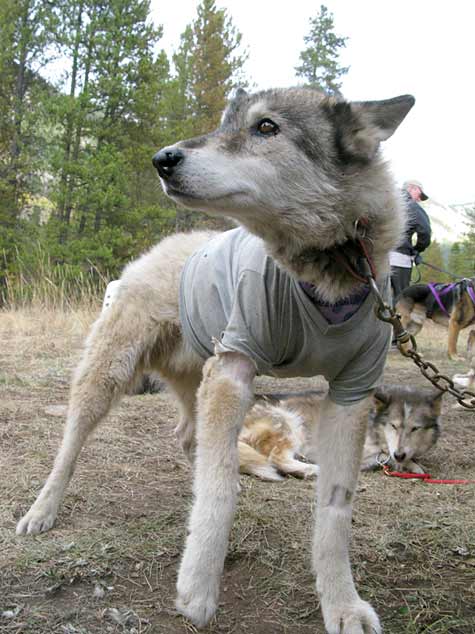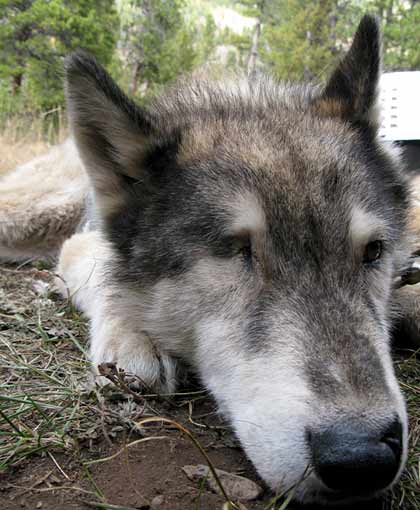Scapula cancer tumors in dogs and cats are rare but if your pet has one, be sure to ask your veterinary surgeon if a “scapulectomy” is an option. This procedure is complicated and not all pets are candidates, but if yours is, a scapulectomy can save the leg!
He’s 13 and fully recovered from a scapulectomy!

Pets who have been diagnosed with an osteosarcoma, chondrosarcoma or fibrosarcoma tumor in the scapula are sometimes candidates for this procedure.
We first learned about scapulectomy procedure when Tripawds Founder Jerry was diagnosed with osteosarcoma in his scapula. Unfortunately his tumor was too large to make him a candidate.
Since then we had completely forgotten about the procedure because nobody had mentioned it here. But in September, longtime Tripawds member and supporter TC Wait told us that one of her sled dogs, 13-year old one-eyed Liam, had just been diagnosed with a chondrosarcoma tumor in his scapula, and he was a potential candidate for the surgery.
Liam was diagnosed with a chondrosarcoma tumor in his scapula.

Dr. Lewis felt that Liam was a good candidate to do a scapulectomy – removing about 75% of his shoulder blade and muscle tissue, but keeping the leg. I guess sort of a partial amputation from the top down? This was a preferred option for Liam because he has arthritis in his “good” shoulder, and keeping a leg under him will help distribute weight down the road. — Liam vs. chondrosarcoma (another dog, another cancer)
TC went ahead with the procedure to partially remove the scapula and chondrosarcoma tumor.
Like the tough old sled dog that he is, Liam bounced back beautifully! As you can see in this November video, he’s getting around great and enjoying winter.
We asked TC’s awesome veterinarian, Dr. Beth A. Lewis, DVM and board certified surgeon at Colorado Veterinary Specialists, if she would educate us about the scapulectomy procedure. She was kind enough to answer all of our questions via email. We hope this provides you with enough information to approach your vet surgeon if you are in the same situation.
Scapulectomy Q&A with Beth Lewis, DVM

A scapula overview:
“The shoulder joint is an articulation between the humerus and scapula (shoulder blade). Unlike many joints, the shoulder is a loose articulation without collateral ligaments. The shoulder is therefore stabilized via the surrounding cuff muscles and their short tendon attachments. Because of this type of articulation there is greater mobility of the shoulder joint in a multi planar aspect. The shoulder blade is stabilized to the chest wall with multiple muscles ( i.e. Serratus ventralis, deltoid, teres, etc.).
Which pets good candidates for a scapulectomy?
When a tumor develops in the forelimb, location is key. If the tumor is on the distal extent of the limb ( i.e. paw, carpus/wrist or elbow). There is very limited tissue to perform a curative intent surgery (i.e. Primary removal) and obtain clean margins because typically 2-4 cm of normal appearing tissues must be excised to remove the microscopic disease as well as the macroscopic disease. Therefore at this location advanced procedures like limb sparing techniques, amputation, radiation therapy should be considered based on the patient and disease.
Scapular tumors are rare but when they are identified are typically osteosarcoma, chondrosarcoma or fibrosarcom … almost always cancerous but subjectively less aggressive than this type of tumor on the distal extremities. Once again location and size is key. When a scapulectomy is considered it is ideal that it involves the dorsal portion of the scapula and remains at least 3-5 cm away from the shoulder joint.
Staging is very important and a CT scan or MRI is essential to ensure that this is an appropriate procedure, lack of extensive tissue invasion and for surgical planning. Either a partial scapulectomy (leaving approximately 1/3 of the scapula to include the glenoid/shoulder joint) or a total scapulectomy (resection of the entire scapula at the level of the shoulder joint) can be considered.
What does a scapulectomy recovery look like?
Dogs tend to perform better with a partial scapulectomy but a complete scapulectomy is a viable option with the right patient. Ideally, smaller well muscled patients tend to perform better with this procedure. If the limb can be preserved in a comfortable and functional way, then this should be strongly considered.
Owner education is also very important. Activity restriction for 4-6 weeks following this procedure is important while the reconstructed muscles heal. Some patients may require a closed suction drain for 5-10 days following this procedure to prevent excessive fluid buildup at the site of scapula removal. Patients will wear a chest wrap for 1-2 weeks to help support the limb during the healing process.
All dogs will have a mechanical lameness following this procedure. This is very important to discuss thoroughly with families. Because the anatomy of the limb has been altered, dogs will appear to “drop” slightly in the affected limb during weight bearing. It is important to note that this lameness is not pain related…it is strictly mechanical and dogs move comfortably after a scapulectomy.
Who should perform a scapulectomy?
The procedure is technically challenging to remove all of the tumor, obtain appropriate margins, avoid important nerves and essential vasculature and should not be attempted without advanced training or direct supervision by someone who has performed this procedure.
I was not taught this procedure in vet school but learned it during advanced training in my surgical residency. This is a wonderful option to consider in patients that would benefit from keeping both front limbs to distribute weight bearing (generalized osteoarthritis, previous fracture in the contralateral limb, etc).
The take home point is that you must have the right tumor, in the right location with the right patient to consider this procedure.
I have performed hundreds of amputations…I have performed 6 partial scapulectomies.”
- See Liam’s scapulectomy recovery therapy.
A Tripawd Mom’s Thoughts on Amputation and Scapulectomy
Just two weeks after Liam’s scapulectomy, we caught up with TC and her sled dogs in Colorado. As a Tripawd mom and now a scapulectomy mom, we asked her to share her thoughts about life on three legs, with or without a scapula and treating a senior dog with these conditions. Here’s what she had to say:
A big THANKS! to Dr. Lewis, TC and of course Liam! We are grateful for this important information they kindly provided to our community!
Hi – my bengal cat jumped and missed the kitchen counter. He his his shoulder hard. After a week, the scapular begun to swell. It was not sore up front. To took him to a very good vet in Athens TX. I thought the outcome was going to be a broken or dislocated issue. After the X-ray, the scapular lite up and Dr said it’s bone cancer. His bloodwork is good.
I went home with pain ointment and I bought CBC oil. The swelling is the same and he has some pain but he’s still scratching in his mat and he is eating a lot, drinking, using the litter box and jumping. It’s now going on week 4. Dr seems to think it will go in to his lungs if it is cancer. If it is not cancer Dr said nothing really can be done. Looking for advice.
Hi Helen. Sorry to hear about your cat. Please please please find a vet more well-versed in treating osteosarcoma in cats. Yes there is a chance it will go to the lungs but that could take a long, long time, and right now your cat needs better pain control, because no pain is greater than osteosarcoma tumors. Cats are masters at hiding how they hurt. We can help find you a specialist. Join our Discussion Forums so we can assist. See you there!
We are sitting in the surgeons office hoping he can do the scapulaectomy for our 7 yr old golden with osteo sarcoma…your article and video gave us a LOT if hope for the outcome!
Oh glad to hear it Tom! Please keep us posted, we hope it works out.
My cat Sam was diagnosed just today with osteosarcoma. The lesion is bug bump coming off his shoulder blade.
I’m interested in learning more about leg saving surgery as his amputation is scheduled for this Friday.
Michelle, we are sorry to hear about the diagnosis. OSA in cats is so rare, but we’ve had quite a few with it here, including Jill the Cancer Fighting Kitty. Your oncologist should be able to tell you if scapulectomy is a possibility. Unfortunately we don’t know of any animals with osteosarcoma who were able to have the procedure, but anything is possible. Let your oncologist know you want to find out if your cat is a candidate and if not, know that cats do very, very well on three legs. We are here to help no matter what you decide.
My 10.5 year old husky mix just had a partial scapulectomy a week and a half ago for an osteosarcoma located in and around the scapula. He is starting his long road of recovery, but his limb was spared.
Awesome article. Very informative. He is very amazing and very amazing that he healed that fast and was able to move around like he did in the snow.